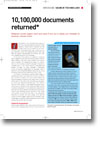
Access all areas
- Article 5 of 26
- M-iD, February 2004
Web sites that do not take into account the needs of users with disabilities are not only discriminatory - they may also be illegal.
Page 1 | Page 2 | Page 3 | All 3 Pages
Device drivers
Another benefit of coding a site to make it accessible, adds Taylor, is that it often results in an interface that is usable by a far wider range of devices - not just the 'assisted device' that a disabled user might use.
“When you talk about PDAs [personal digital assistants], for example, they're quite strongly allied to the type of support available in an assisted device for accessing the web,” he explains. “They support only text, use URLs based in HTML, and don't support JavaScript or Flash.”
So if a site is usable for a mobile device with a stripped-down web browser and small display, it is probably accessible to the disabled, and vice versa.
Cascading style sheets (CSS), often used to ensure a group of web pages all use the same fonts and colours, are a powerful tool for changing how content appears on different devices. “The main thing is that they separate the content from the layout and make it easier for assisted devices to understand what's going on,” explains Taylor.
Instead of marking up a web page to make its content appear in a particular way, a web designer using CSS can keep the content in the web page while leaving the information on its presentation in a separate style sheet.
Different style sheets, moreover, can be specified for different situations - a screen reader, web browser, mobile phone or printer can each have a different style sheet that will format the page and hide or reveal content appropriately - so a single page can appear radically different to different users without having to be rewritten. And since style sheets only have to be downloaded once, they can even reduce server load as the formatting that used to be embedded in every web page now only appears in the style sheet.
The developers of the major web page design tools have been working hard to incorporate CSS support into their programs over the last few years. “Two or three years ago, we realised there was a significant opportunity - and requirement - to support people with disabilities,” says Macromedia's UK MD Fiona Coughlan. “If you look at the legislation coming into Europe and the UK, it's some of the most stringent possible in terms of deploying web sites to customers.”
With each successive release of Dreamweaver, Macromedia's flagship web design tool, CSS support has been increased and accessibility features enhanced, claims Coughlan. Macromedia has licensed some of Usablenet's software so that it can not only go through a web site highlighting colours that would be difficult for some users to perceive, and identifying which fonts should be used and so on, it will also educate designers about aspects of design that will make it easier or harder for disabled users to access the site.
Perfect accessibility
Other tools are making it easier to serve accessible content for an entire site. A content management system, when used correctly, should simply be able to pass content into accessible web page templates. “If each page is coded individually,” points out Nielsen, “there are 10,000 opportunities for a designer to code wrongly. With a CMS, you only have to get it right once.”
Fortunately, says Nielsen, it is not usually the case that organisations have to spend considerable money on a 'big bang' project to maximise their web sites' accessibility. “To make a web site perfectly accessible is difficult. But it's not a choice of perfection or nothing - if it were that choice, most companies would choose nothing. There is a third choice: to make it more accessible, which is easy,” he says.
Page 1 | Page 2 | Page 3 | All 3 Pages

